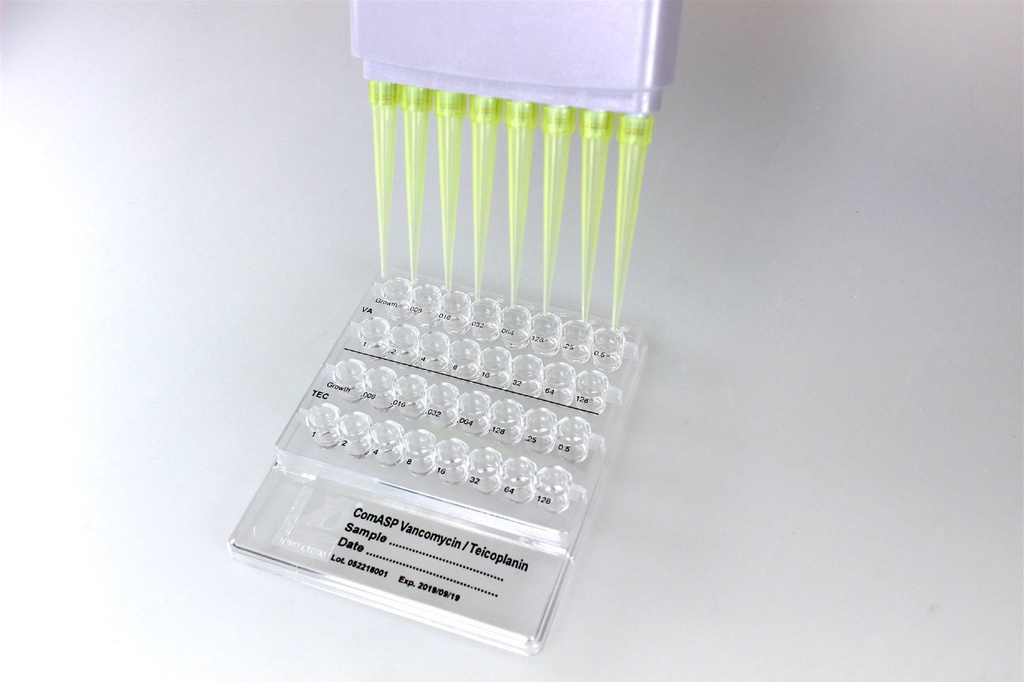Liofilchem™ ComASP™ Vancomycin (0.008-128 μg/mL) MIC Broth Microdilution Panel, for 8 Tests
Catalog No :
CAS Number :
Brand :
In Stock
Specifications:
| Application | Clinical microbiology |
| Storage Temperature | -20°C |
| Product Type | Microdilution Panel |
| Product Brand | Liofilchem |
| Product Grade | Microbiology grade |
The Liofilchem™ ComASP™ Vancomycin MIC Broth Microdilution Panel is a precision tool for determining the Minimum Inhibitory Concentration (MIC) of vancomycin against Gram-positive bacterial pathogens. With an MIC range of 0.008–128 µg/mL, this panel is ideal for detecting susceptibility and resistance in pathogens such as Staphylococcus aureus (including MRSA) and Enterococcus spp. (including VRE).
Designed for clinical microbiology laboratories, the ComASP™ system ensures accuracy and compliance with international standards, making it an essential tool for monitoring antimicrobial resistance and guiding appropriate therapy.
Key Features
1. Wide MIC Range
- 0.008–128 µg/mL range covers susceptibility, intermediate, and resistance thresholds for vancomycin.
- Enables precise detection of both low- and high-level resistance.
2. Standardized Broth Microdilution Format
- Recognized as the gold standard for antimicrobial susceptibility testing.
- Ensures reproducibility and consistency of results.
3. Ready-to-Use Panels
- Preloaded with vancomycin concentrations for 8 tests.
- Saves time and minimizes preparation errors.
4. High Sensitivity and Specificity
- Effectively detects vancomycin resistance in critical pathogens, including Vancomycin-Resistant Enterococci (VRE) and Vancomycin-Intermediate Staphylococcus aureus (VISA).
5. Compliance
- Meets CLSI and EUCAST guidelines for antimicrobial susceptibility testing.
6. Compact Design
- User-friendly panel designed for efficient use in clinical and research laboratories.
Specifications
| Feature | Details |
|---|---|
| Antibiotic Tested | Vancomycin |
| MIC Range | 0.008–128 µg/mL |
| Test Type | Broth Microdilution |
| Format | Preloaded MIC panel for 8 tests |
| Storage Conditions | Store at -20°C for long-term stability |
| Incubation Conditions | Aerobic, 35–37°C, 16–20 hours |
| Shelf Life | Typically 2 years under proper storage conditions |
| Applications | Clinical, research, and antimicrobial resistance studies |
Storage and Handling
1. Long-Term Storage
- Store at -20°C to preserve stability and efficacy.
- Avoid repeated freeze-thaw cycles to maintain test accuracy.
2. Short-Term Storage
- Panels may be stored at 2–8°C for short durations (up to two weeks).
3. Handling
- Bring panels to room temperature before use to avoid condensation and ensure proper reconstitution of reagents.
Applications
1. Clinical Diagnostics
- Quantitative MIC determination for vancomycin to guide effective treatment in infections caused by Gram-positive pathogens.
2. Resistance Detection
- Identifies resistance mechanisms in Enterococcus (e.g., VRE) and Staphylococcus aureus (e.g., VISA and VRSA).
3. Research and Development
- Used in antimicrobial resistance studies and drug development.
4. Infection Control
- Essential for monitoring nosocomial infections and implementing antibiotic stewardship programs.
Advantages
- Accurate and Reliable:
- Provides precise MIC results, essential for tailoring antimicrobial therapy.
- Efficient and Convenient:
- Ready-to-use panels reduce setup time and minimize errors.
- Internationally Accepted:
- Conforms to CLSI and EUCAST guidelines for global applicability.
- Wide Coverage:
- Effective for low- and high-level resistance detection in Gram-positive bacteria.
- High-Quality Manufacturing:
- Consistent performance supported by Liofilchem’s rigorous quality control processes.
Why Choose Liofilchem™ ComASP™ Vancomycin MIC Panels?
The Liofilchem™ ComASP™ Vancomycin MIC Broth Microdilution Panel is an essential tool for accurately determining vancomycin susceptibility and resistance. Its broad MIC range, ready-to-use format, and compliance with international standards make it indispensable for clinical laboratories and research institutions working to combat antimicrobial resistance.




 0
0
